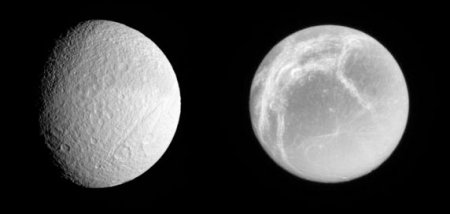Centauri Dreams doubts that most space scientists expected to find as much activity around Saturn as the Cassini probe has revealed. Enceladus was spectacular enough, with its geysers spewing material hundreds of kilometers above the surface. And now we find indications that two other moons — Tethys and Dione — are active worlds as well. More Cassini close passes will be needed to firm this up. For that matter, data already collected from previous flybys may contain still more clues, which is how things work in planetary science these days — we collect information at a rate far surpassing our ability to keep up with the inflow.
In any event, Cassini’s arrival in Saturn space in 2004 made it clear that centrifugal forces caused by the planet’s fast rotation (10 hours and 46 minutes) compressed plasma into a disc from which cold, dense plasma from the planet’s inner magnetosphere was being flung into space. Hotter plasma from the outer magnetosphere quickly moves in to fill up the gap. The plasma, made up of negatively charged electrons and positively charged ions, is readily manipulated by the giant planet’s magnetic field.
This European Space Agency news release explains how Jim Burch (Southwest Research Institute) and colleagues have used Cassini’s Plasma Spectrometer to pinpoint the source of at least some of the ejected electrons near the orbits of Tethys and Dione. “This new result, says Andrew Coates (University College, London), “seems to be a strong indication that there is activity on Tethys and Dione as well.” Thus the possibility that both these moons are undergoing interesting geological processes that we’ll soon be studying via future flybys.

Image: Image: This is a compound image made from separate images of Saturn’s two moons, Tethys (to the left) and Dione (to the right), taken by Cassini. The two moons are flinging great streams of particles into space, according to data from the NASA/ESA/ASI Cassini mission to Saturn. The discovery suggests the possibility of some sort of geological activity, perhaps even volcanic, on these icy worlds. Credit: NASA/ JPL.
The paper on this work is Burch et al., “Tethys and Dione as sources of outward-flowing plasma in Saturn’s magnetosphere,” Nature 447, pp. 833-835 (14 June, 2007), with abstract here. With the telltale electrons now detected, Burch’s team now looks toward tracking ion activity as the study of plasma around these small moons intensifies.


Saturn moon ‘once had ocean’
By Paul Rincon
Science reporter, BBC News, Houston
The Ithaca Chasma is thought to be a very old structure
One of Saturn’s moons may once have harboured a liquid ocean beneath its icy surface, scientists have told a major conference in Houston, Texas.
Tethys is a mid-sized satellite with a density close to that of pure ice.
But a large valley system visible today must have formed when the crust was being heated and under great strain.
The team thinks that tidal heating, followed by cooling which froze Tethys’ ocean, could have formed the giant Ithaca Chasma rift.
Details were presented here at the 39th Lunar and Planetary Science Conference.
Full article here:
http://news.bbc.co.uk/2/hi/science/nature/7297408.stm